Within the realm of feline health, stomatitis stands as a formidable adversary to cats' oral comfort and well-being. As a condition that can progress insidiously if not promptly addressed, the symptoms of stomatitis can be subtle yet consequential.
Understanding the nuances of this inflammatory process, its treatment options, and the pivotal role of proactive care in maintaining oral health for our feline companions is crucial. Exploring the multifaceted aspects of stomatitis management not only sheds light on its complexities but also underscores the significance of vigilance and informed decision-making in safeguarding your kitty's mouth.
Key Takeaways
- Stomatitis causes painful gum swelling in cats, requiring professional treatment.
- Symptoms include red gums, bad breath, and difficulty eating, emphasizing the need for veterinary care.
- Full-mouth extraction is a common extreme treatment option for stomatitis in cats.
- Regular vet check-ups and dental care are crucial in managing stomatitis and maintaining oral health in cats.
Overview of Stomatitis in Cats
Stomatitis in cats is a painful condition characterized by swelling of the gums and oral tissues, often leading to significant discomfort and potential dental complications if left untreated. This inflammatory response can be triggered by various factors, including viral infections like calicivirus, feline leukemia virus, and feline immunodeficiency virus. While the exact cause remains elusive, the impact on a cat's quality of life is unmistakable.
Cats suffering from stomatitis may exhibit symptoms such as swollen, red gum tissue, bad breath, drooling, and difficulty eating. Prompt veterinary attention is crucial to manage this condition effectively and prevent further deterioration. Regular dental check-ups and proactive care play vital roles in maintaining your furry friend's oral health and overall well-being.
Common Symptoms to Watch For
When observing cats for signs of stomatitis, it is essential to be vigilant for common symptoms that could indicate the presence of this painful oral condition.
Common Symptoms to Watch For:
- Swollen and red gums
- Inflammation in the mouth
- Bad breath
- Drooling and difficulty eating
These signs may suggest the presence of stomatitis in your furry friend. If you notice any of these symptoms, it is crucial to seek prompt veterinary care to address the issue effectively.
Early detection and intervention can help alleviate your cat's discomfort and prevent further oral health complications. Stay attuned to these common signs to ensure your kitty receives the necessary attention and care for their stomatitis.
Age Considerations and Clinical Signs
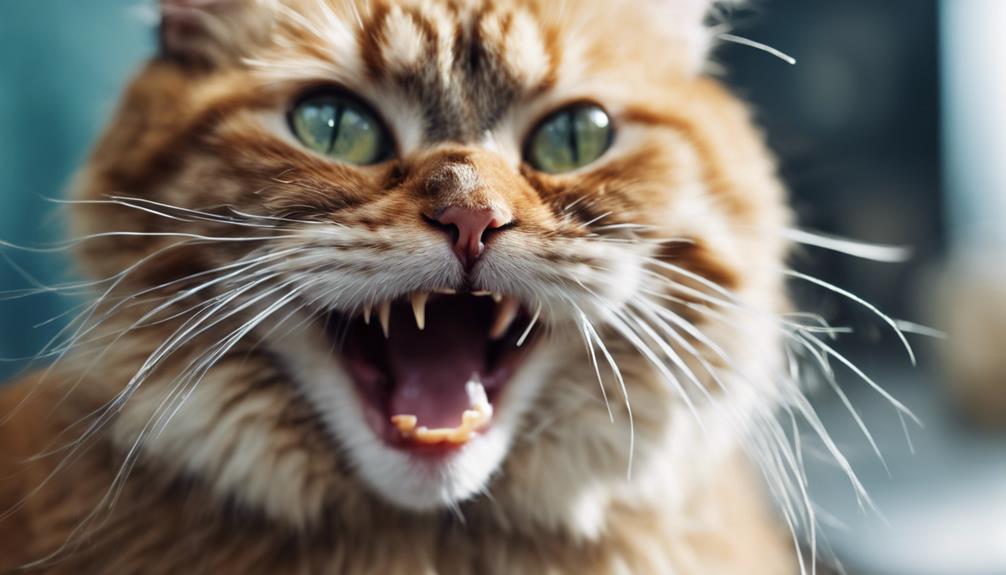
In veterinary practice, understanding the age-related factors and distinctive clinical signs associated with stomatitis in cats is essential for effective diagnosis and treatment.
While stomatitis can affect cats of all ages, older cats are more prone to developing this painful condition. Senior cats may exhibit symptoms such as swollen gums, oral inflammation, bad breath, drooling, and reluctance to eat.
It's crucial for cat owners to monitor their feline companions closely for these signs, especially as they age, as early detection can lead to prompt veterinary intervention. Regular dental check-ups are particularly important for senior cats to maintain oral health and overall well-being.
Importance of Veterinary Check-ups
Understanding the age-related factors and clinical signs of stomatitis in cats underscores the importance of regular veterinary check-ups in ensuring early detection and timely intervention for oral health issues. Regular vet check-ups play a vital role in maintaining your cat's overall well-being. Here are four reasons why these check-ups are crucial:
- Early Detection: Regular visits allow vets to catch stomatitis or other oral health issues early.
- Preventive Care: Routine check-ups help prevent the progression of dental diseases in cats.
- Professional Guidance: Vets can provide guidance on oral hygiene practices tailored to your cat's needs.
- Timely Intervention: Prompt veterinary care can alleviate pain and discomfort associated with stomatitis.
Treatment Approaches for Stomatitis
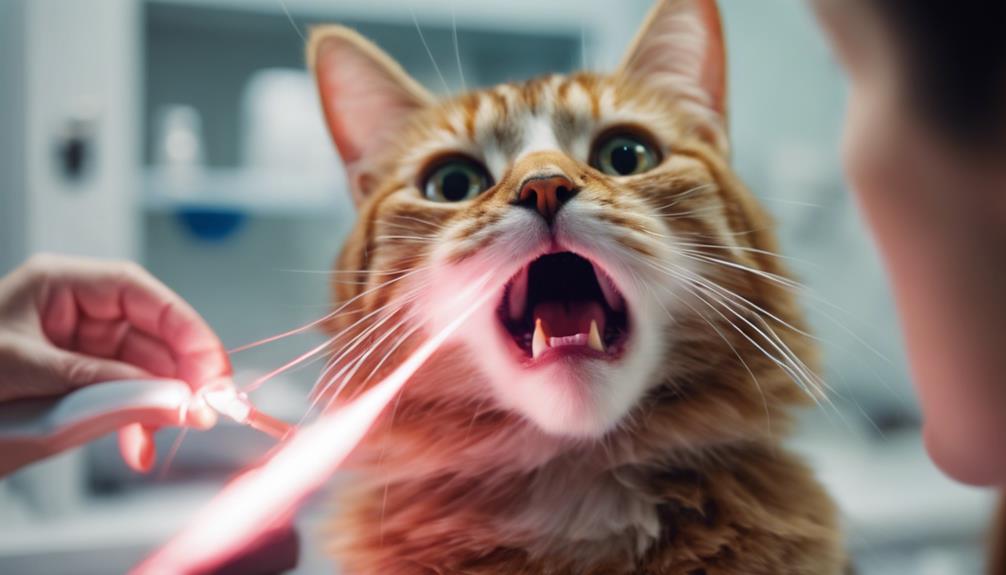
Implementing a comprehensive treatment plan is essential in managing stomatitis in cats effectively. When addressing this condition, various treatment approaches can be considered to alleviate discomfort and improve the quality of life for your feline companion. Below is a table summarizing common treatment options for stomatitis in cats:
| Treatment Approach | Description | Benefits |
|---|---|---|
| Anti-inflammatory Meds | Reduce oral inflammation and pain | Provide relief from discomfort |
| Antibiotics | Combat bacterial infections | Aid in controlling secondary infections |
| Full-mouth Extraction | Removal of all teeth | Eliminate source of inflammation |
| Laser Therapy | Targeted treatment for oral tissues | Promote healing and reduce inflammation |
Pain Management and Medication
Effective pain management plays a crucial role in enhancing the quality of life for cats suffering from stomatitis. To ensure your kitty's comfort, consider the following pain management strategies:
- Prescription Pain Medication: Veterinarians may prescribe pain relief medications like buprenorphine or gabapentin to alleviate your cat's discomfort.
- Anti-Inflammatory Drugs: Nonsteroidal anti-inflammatory drugs (NSAIDs) can help reduce inflammation and pain in your cat's mouth.
- Local Anesthetics: Topical treatments such as lidocaine gels can provide targeted pain relief directly to the affected areas.
- Nutritional Support: Special soft diets or liquid meals can help your cat receive necessary nutrients without causing additional pain during eating.
Extreme Treatment: Full-Mouth Extraction

The definitive treatment option for severe cases of stomatitis in cats involves the complete removal of all teeth, known as Full-Mouth Extraction (FME). While it may seem extreme, FME is often the most effective way to alleviate the intense pain and inflammation associated with stomatitis.
By removing the teeth, the source of chronic oral infection is eliminated, providing relief and improving the cat's quality of life. After FME, most cats can still eat dry or wet food without issue, as they adapt by using their gums for chewing.
Although it may sound drastic, FME can be a game-changer for cats suffering from severe stomatitis, offering a chance for a significantly improved and pain-free life.
Dental Care Challenges and Solutions
Dental care challenges faced by cats with stomatitis necessitate tailored solutions for alleviating their oral discomfort and enhancing their quality of life. When caring for a kitty with stomatitis, it's essential to address these challenges with targeted strategies:
- Pain Management: Finding effective ways to manage your cat's pain during dental care procedures.
- Specialized Diet: Offering a diet that is easy for your cat to eat and won't exacerbate their oral inflammation.
- Gentle Oral Hygiene: Implementing gentle oral hygiene practices that don't cause additional discomfort.
- Regular Veterinary Monitoring: Ensuring consistent check-ups with your vet to monitor your cat's oral health and adjust treatment as needed.
Home Care Tips for Cats
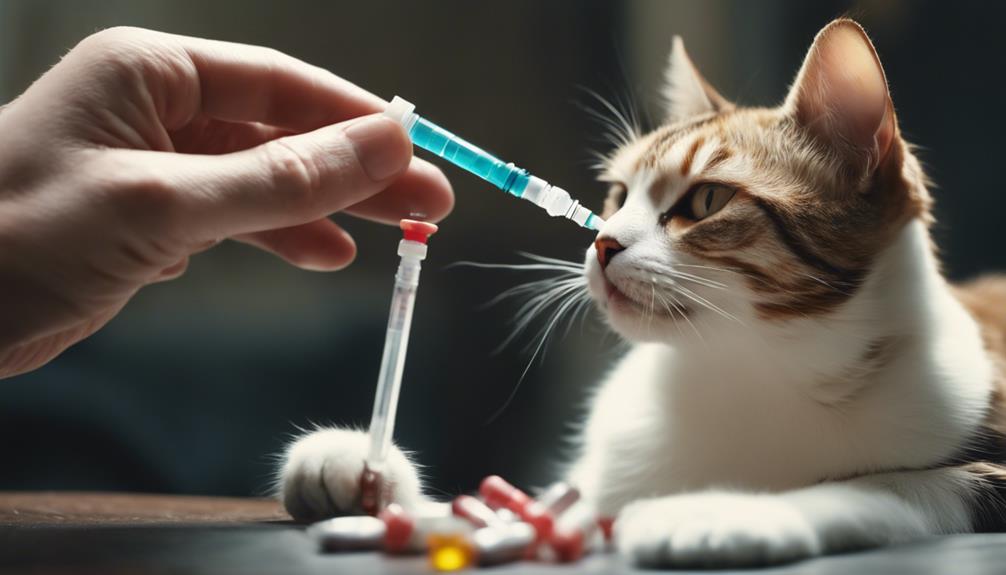
Implementing appropriate home care practices is essential for managing stomatitis in cats and maintaining their oral health. To help alleviate your kitty's discomfort, consider feeding soft, moist food to ease chewing and reduce irritation.
Regularly brushing your cat's teeth with a feline-specific toothbrush and toothpaste can help prevent plaque buildup and reduce inflammation. Providing safe chew toys or dental treats can also aid in keeping your cat's teeth clean.
Additionally, creating a calm and stress-free environment for your cat can promote healing and overall well-being. Observing your cat for any changes in behavior or eating habits and scheduling routine check-ups with your veterinarian are vital components of home care for cats with stomatitis.
Preventive Measures and Awareness
To effectively combat stomatitis in cats and ensure their long-term oral health, proactive preventive measures and heightened awareness among pet owners play a pivotal role. Here are four essential steps to help protect your feline companion from this painful condition:
- Regular Dental Check-ups: Schedule routine dental exams for your cat to catch any oral health issues early.
- Healthy Diet and Dental Care: Provide a balanced diet and engage in dental care practices recommended by your veterinarian.
- Watch for Warning Signs: Be attentive to symptoms like swollen gums, bad breath, or difficulty eating, and seek prompt veterinary attention if noted.
- Educate Yourself: Learn about common dental issues in cats, preventive measures, and the importance of oral hygiene to better care for your pet.
Dental Health Resources for Pet Owners
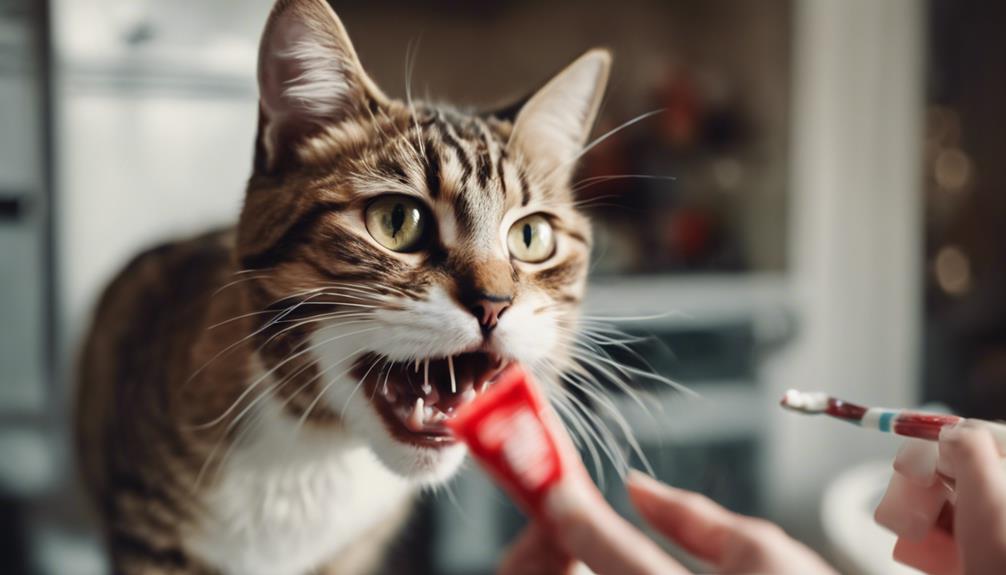
Pet owners can access a variety of valuable resources to enhance their understanding of maintaining optimal oral health for their furry companions. These resources include guides on cat dental exams both at home and with a vet, signs of eye infections in cats, reasons why cats lick themselves, spotting tooth decay in dogs, and comparing a dog's mouth cleanliness to humans.
Other resources cover topics such as feline calicivirus and rabies in cats, hassle-free teeth brushing for cats, tips for keeping a dog's teeth clean, and preventing periodontal disease in dogs. By utilizing these resources, pet owners can proactively care for their pets' dental health, recognize symptoms of oral issues, and seek timely veterinary care to ensure their furry friends lead healthy and happy lives.
Connection Between Stomatitis and Other Diseases
A correlation exists between stomatitis in cats and certain underlying diseases, indicating a potential interplay between oral health and systemic conditions. This connection highlights the importance of holistic care in managing stomatitis and its possible impacts on overall feline health. Understanding these associations can aid in comprehensive treatment strategies and improve the well-being of affected cats.
To shed light on this crucial link, consider the following:
- Feline Immunodeficiency Virus (FIV)
- Feline Calicivirus Infection
- Chronic Kidney Disease
- Inflammatory Bowel Disease (IBD)
Impact of Stomatitis on Cats' Quality of Life
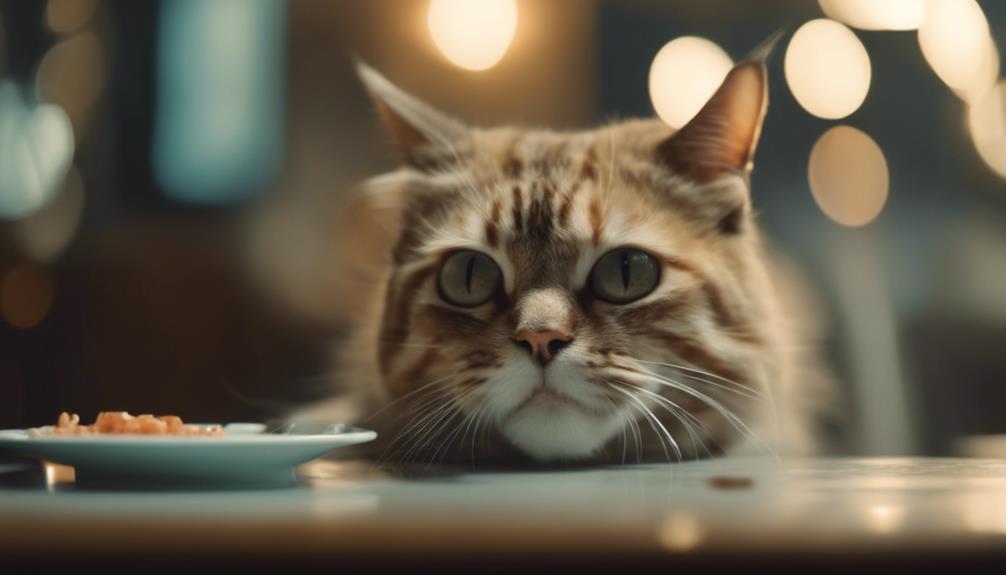
The interplay between stomatitis in cats and underlying diseases underscores the significant impact this oral condition can have on the overall quality of life of affected felines. Cats suffering from stomatitis often experience excruciating pain, leading to difficulties in eating, grooming, and interacting with their human companions.
The chronic discomfort caused by stomatitis can result in behavioral changes, such as irritability or withdrawal. Additionally, the constant inflammation in the mouth can lead to secondary health issues, affecting the cat's overall well-being.
As a result, addressing stomatitis promptly and effectively is crucial not only for alleviating the physical pain but also for enhancing the emotional and social aspects of a cat's life.
Addressing Myths and Misconceptions
Misconceptions surrounding the causes and treatment of stomatitis in cats often lead to confusion and misinformation among pet owners and caregivers. To clarify the facts, here are four common myths debunked:
- Myth: Stomatitis is solely caused by poor dental hygiene.
- Myth: Stomatitis is curable with natural remedies alone.
- Myth: Only older cats can develop stomatitis.
- Myth: Stomatitis is always contagious to other pets in the household.
Conclusion: Caring for Your Cat's Mouth
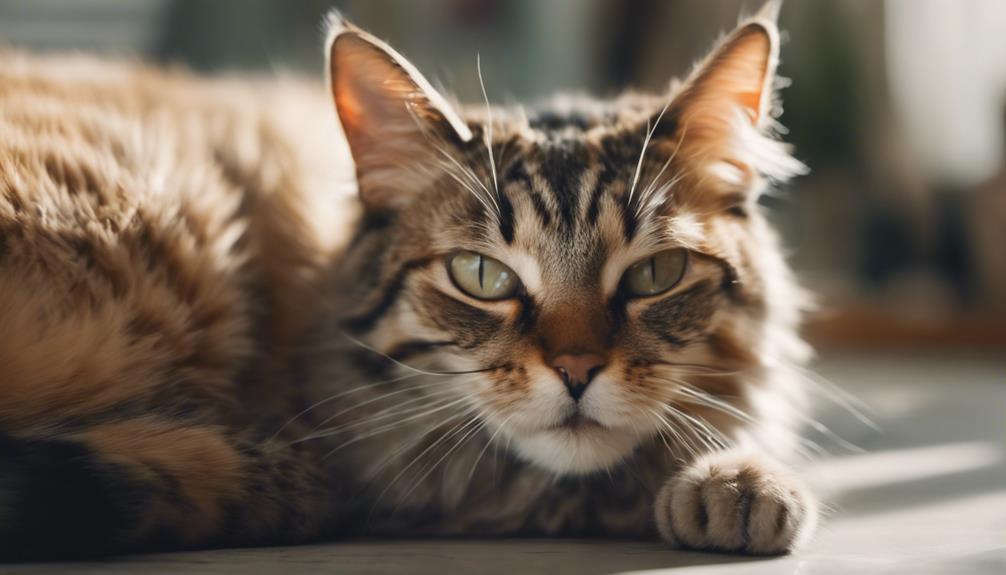
Concluding our discussion on caring for your cat's mouth, prioritizing regular veterinary check-ups remains essential for early detection and management of stomatitis. These check-ups allow veterinarians to monitor your cat's oral health, identify any signs of stomatitis or other dental issues, and provide timely intervention.
In addition to professional care, maintaining good dental hygiene at home is crucial. This includes regular teeth brushing, providing dental treats or toys, and ensuring a balanced diet to support oral health. Observing your cat's behavior and eating habits can also help in detecting any potential problems early on.
Frequently Asked Questions
Can Stomatitis in Cats Be Prevented Through Specific Dietary Changes or Supplements?
Preventing stomatitis in cats through specific dietary changes or supplements remains inconclusive. While diet and supplements may support overall oral health, consult a veterinarian for tailored advice. Regular dental care, timely vet check-ups, and prompt treatment are key preventive measures.
Are There Alternative Treatment Options Available for Cats With Stomatitis, Aside From Full-Mouth Extraction?
Alternative treatment options for cats with stomatitis, beyond full-mouth extraction, may include immunosuppressive drugs, laser therapy, or oral pain management techniques. Consult with a veterinary professional to explore tailored approaches for your cat's specific condition.
How Can Pet Owners Differentiate Between Regular Dental Care and Specialized Dental Care for Cats With Stomatitis?
Differentiating between regular and specialized dental care for cats with stomatitis involves recognizing the need for advanced treatments like full-mouth extraction, anti-inflammatory drugs, and antibiotics. Consult your veterinarian for tailored care plans.
Is There a Link Between Stomatitis in Cats and Other Underlying Health Conditions That May Exacerbate the Disease?
While the exact link between stomatitis in cats and other underlying health conditions remains unclear, factors such as calicivirus, feline leukemia virus, and feline immunodeficiency virus may contribute to the exacerbation of this painful oral disease. Regular vet check-ups are essential.
Are There Support Groups or Online Resources Available for Pet Owners Dealing With the Emotional Toll of Managing Stomatitis in Their Cats?
Support groups and online resources are valuable for pet owners managing the emotional toll of stomatitis in cats. These platforms offer shared experiences, advice, and emotional support, fostering a sense of community and understanding during challenging times.
Conclusion
In conclusion, stomatitis in cats poses a significant threat to their oral health and overall well-being. Recognizing the symptoms, seeking timely veterinary care, and exploring appropriate treatment options are crucial steps in managing this inflammatory condition.
By prioritizing preventive measures and promoting dental hygiene practices, cat owners can play a vital role in safeguarding their feline companions against the potential complications of stomatitis.
Vigilance and proactive care are essential in ensuring the optimal health and quality of life for cats affected by this condition.




